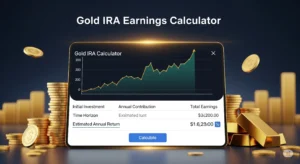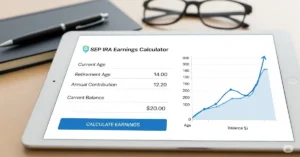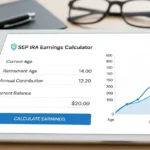Self-Directed IRA Earning Calculator: A Guide
Welcome to smartretireplans.com, your home for cutting-edge retirement strategies and tools.
For many years, the path to a successful retirement was a simple one: invest in stocks, bonds, and mutual funds, and hope the market grows steadily over time. But for a new generation of savvy investors, a powerful new strategy has emerged. The Self-Directed IRA (SDIRA) allows you to invest your retirement funds in a world of alternative assets, from real estate to private equity, providing the potential for a new level of growth and diversification.
But how do you even begin to understand the potential of these investments? How can you visualize the future value of a real estate deal or a private lending note held within your tax-advantaged account?
That’s where this page comes in. On this page, you will find our ultimate tool for retirement planning: the Self-Directed IRA earning calculator. This isn’t just a simple number-cruncher. It is a powerful engine designed to help you project the growth of your SDIRA, allowing you to explore different scenarios and see how alternative assets can transform your retirement nest egg.
In this comprehensive guide, we will walk you through everything you need to know about the Self-Directed IRA earning calculator. We will cover:
- What a Self-Directed IRA is and why it’s different.
- The transformative power of compounding with alternative assets.
- A detailed, step-by-step guide on how to use the Self-Directed IRA earning calculator.
- Real-world case studies to help you interpret the results.
- The crucial rules and risks you must know before you get started.
Let’s begin and unlock the true potential of your retirement funds.
Part 1: What Exactly is a Self-Directed IRA?
Before you can use our Self-Directed IRA earning calculator, you need to understand the fundamental concept behind the account itself.
A traditional IRA is a retirement account that holds publicly traded assets like stocks, bonds, and mutual funds. It is a powerful tool for retirement savings. A Self-Directed IRA takes this concept and expands on it exponentially. While an SDIRA can also hold traditional assets, it is primarily used to invest in alternative assets, which are not typically available in a standard IRA.
These alternative assets include:
- Real Estate: Residential homes, commercial properties, raw land, rental properties, and more.
- Private Lending: Acting as the lender on a mortgage or business loan.
- Private Equity: Investing in private companies or startups.
- Precious Metals: Gold, silver, platinum, and palladium.
- Cryptocurrencies: Bitcoin, Ethereum, and other digital assets.
The key difference is that with a Self-Directed IRA, you are in control. You identify the investment, you perform the due diligence, and you direct the custodian (the financial institution that holds the account) to make the transaction.
Part 2: The Transformative Power of Compounding with Alternative Assets
The most significant benefit of any retirement account is the power of compounding. When your earnings start generating their own earnings, your wealth grows exponentially over time. This effect is magnified when those earnings are tax-free or tax-deferred.
The Self-Directed IRA earning calculator helps you visualize this powerful effect, especially with the higher potential returns often associated with alternative assets. While stocks have historically averaged returns in the 8-10% range, well-executed alternative asset investments can sometimes generate higher returns.
- Real Estate: A well-chosen rental property can generate both rental income and property appreciation. A private equity investment in a successful startup could yield multi-bagger returns.
- Private Lending: A private mortgage loan could offer a fixed interest rate of 8-12% or more, providing a predictable, high-yield income stream.
Our Self-Directed IRA earning calculator is the perfect tool for modeling these scenarios. By inputting a realistic, higher rate of return, you can see just how a single successful investment can accelerate your retirement savings.
Part 3: How to Use the Self-Directed IRA Earning Calculator
Using the Self-Directed IRA earning calculator is simple and intuitive. Each field is designed to help you model your specific financial situation and investment strategy.
Here’s a breakdown of each input field:
1. Initial Investment
This is the amount of money you are starting with. It could be a new contribution, or more likely, it’s a rollover from an old 401(k) or a transfer from an existing IRA. A lump-sum investment in an SDIRA can provide a powerful starting point for your first alternative asset deal.
2. Annual Contribution
This is the amount of money you plan to contribute each year. Consistency is a crucial component of any successful retirement plan. Even if you’re not making new investments every year, consistent contributions can be used to pay for property expenses or to fund a future deal.
3. Annual Rate of Return
This is the most important and most variable input field. Unlike a standard retirement calculator that might pre-populate a historical stock market average, you get to choose your rate of return. This is where you can explore the potential of your alternative assets.
- For a rental property: Use a conservative estimate that blends your expected rental income and property appreciation.
- For a private loan: Use the interest rate of the loan itself.
- For a risky venture: Use a higher number to see the potential upside, but remember to also run a scenario with a lower or negative number to understand the risk.
4. Investment Time Horizon
This is the number of years you plan to keep your money invested. The longer your time horizon, the more your money will compound. If you’re 30, you might input 35 years. If you’re 55, you might input 10 years. Time is your greatest asset in a retirement plan.
Once you input these numbers and hit “Calculate,” our Self-Directed IRA earning calculator will instantly show you a breakdown of your future balance, including your total contributions and your total tax-advantaged earnings.
Part 4: Real-World Scenarios with the Calculator
To show you the true power of our Self-Directed IRA earning calculator, let’s run a few hypothetical scenarios based on real-world alternative asset returns.
Scenario 1: The Young Investor with a Long Time Horizon
- Initial Investment: $10,000 (a rollover from an old job)
- Annual Contribution: $6,500 (the annual IRA limit)
- Annual Rate of Return: 10% (a realistic return for a diversified real estate portfolio with a blend of rentals and passive debt investments)
- Investment Time Horizon: 35 years
Result: The Self-Directed IRA earning calculator will show you a projected final balance of over $2.4 million. Of this amount, over $2.1 million is tax-free earnings. This demonstrates the immense power of starting early with a long time horizon.
Scenario 2: The Mid-Career Professional with Consistent Contributions
- Initial Investment: $50,000 (a rollover from an old 401(k))
- Annual Contribution: $10,000 (a mix of annual contributions and catch-up contributions)
- Annual Rate of Return: 12% (a return targeted through strategic private lending to real estate investors)
- Investment Time Horizon: 20 years
Result: Our Self-Directed IRA earning calculator will project a final balance of over $1.1 million. Of this, nearly $700,000 would be from tax-advantaged earnings. This shows how consistent contributions can quickly build wealth over a mid-range time period.
Scenario 3: The Investor with a Large Initial Investment
- Initial Investment: $250,000 (a transfer from a Traditional IRA)
- Annual Contribution: $0 (no additional contributions)
- Annual Rate of Return: 15% (a high-return target from a single, successful real estate flipping venture or a private equity investment)
- Investment Time Horizon: 10 years
Result: The Self-Directed IRA earning calculator will show a projected balance of over $1 million. Of this amount, over $750,000 is pure tax-deferred earnings. This demonstrates the immense power of a large, high-return investment in a relatively short time frame.
Part 5: The Fine Print: Rules, Risks, and Considerations
While the numbers from our Self-Directed IRA earning calculator are exciting, it is critical to understand the rules and risks before you start. An SDIRA is not a simple account, and there are severe penalties for missteps.
The IRS’s Strict Rules
The IRS prohibits “self-dealing,” which is any transaction between your IRA and a “disqualified person.” A disqualified person includes you, your spouse, your children, your parents, and any entity you control.
This means you can’t:
- Live in, use for vacation, or store your personal items in a property owned by your SDIRA.
- Perform any work on a property (no “sweat equity”). All labor must be paid for with IRA funds.
- Buy a property from or sell a property to a disqualified person.
The Tax on Debt-Financed Income (UBIT)
Another critical rule to be aware of is Unrelated Business Taxable Income (UBIT). If your SDIRA uses a non-recourse loan to purchase a property, the portion of the income generated by the debt-financed part of the property can be subject to tax. It is a complex rule, and you should always consult a professional for guidance.
The Risks of Alternative Assets
Alternative assets are often illiquid, meaning they can’t be quickly converted to cash. They also require a high degree of due diligence. While the potential for high returns is real, so is the potential for losses.
Conclusion: Use the Calculator to Plan, Not to Predict
The Self-Directed IRA earning calculator is not a crystal ball. It is a powerful planning tool. It helps you visualize the potential of alternative asset investing and understand the dramatic impact of compounding, contributions, and time.
By running different scenarios, you can gain a deeper understanding of the possibilities and get a feel for what it takes to reach your retirement goals. Use it to explore the power of an SDIRA and to see how a high-return alternative asset can fit into your overall retirement strategy.
As you embark on this journey, remember to combine the insights from our calculator with thorough due diligence and a consultation with a qualified financial advisor. Happy calculating!
Self-Directed IRA earning calculator
A Self-Directed IRA (SDIRA) is a type of retirement account that allows you to invest in a wider range of assets than a traditional IRA. While a regular IRA is limited to stocks, bonds, and mutual funds, an SDIRA gives you the freedom to invest in alternative assets such as real estate, private equity, precious metals, and private loans.
How accurate is the Self-Directed IRA earning calculator?
The Self-Directed IRA earning calculator is a powerful tool for projecting potential growth, but it is not a guarantee of future performance. The calculator’s accuracy depends entirely on the numbers you input, especially the “Annual Rate of Return.” It’s best used as a planning tool to help you visualize different scenarios and understand the long-term potential of your investments, rather than as a precise prediction.
What are some of the key IRS rules I must know before investing?
The most critical rule is avoiding “prohibited transactions,” which means you cannot engage in any form of self-dealing. This includes buying a property from yourself, living in a property owned by your SDIRA, or performing any personal labor on a property. You must also be aware of rules related to “Unrelated Business Taxable Income” (UBIT), which can be triggered when using a non-recourse loan to purchase property within your SDIRA.
What kind of investments can I make with an SDIRA?
With a Self-Directed IRA, you can invest in a wide range of alternative assets. The most common are real estate (rental properties, commercial buildings, raw land), private loans (like a mortgage note), private equity, and precious metals. As long as the investment is not a prohibited transaction, you are generally free to pursue it.
How do I estimate the “Annual Rate of Return” for the calculator?
Estimating the annual rate of return for a Self-Directed IRA requires research and due diligence. Unlike a stock market index, there is no standard return. For real estate, you can project a combination of expected rental income and property appreciation. For a private loan, you can use the fixed interest rate of the loan itself. The key is to use a realistic and conservative number based on your specific investment strategy.













